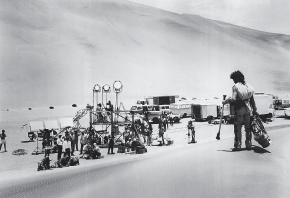Movies and Film: Blitz-Klieg: A Brief History of Black-and-White Film
Blitz-Klieg: A Brief History of Black-and-White Film
Even if we don't know the history of color in film, we can feel that it has one. Black and white are the tones of old films; color is the color of today. This section will give a bit of depth to that intuition.
Filmophile's Lexicon
Orthochromatic film stock was used in the production of silent film from its earliest days to about the mid-1920s. Its main limitation was that it was not sensitive to yellows and reds, which then did not show up as any appreciable shade of gray at all on this black-and-white film.
Black-and-White Film Stock
Early orthochromatic film stock profited from the history of nineteenth-century photographic photography, which had invented film able to photograph at fairly rapid shutter speed, so that even the quick movements of racing cars, moving trains, and galloping horses could be photographed without blur. Orthochromatic film stock, the earliest widely used film, was initially much faster than the presumably superior panchromatic film stock (superior because it could register more colors). In fact, there was an overlap in the 1920s when both were used. Panchromatic ultimately won out, however, because, without filter adaptation, the older orthochromatic stock had a difficult time registering such things as clouds in the sky. Also, panchromatic stock registered images quickly, so it could be used for indoor, more moody lighting effects, instead of simply outdoors, where the natural lighting was brightest.
Early Lighting for Early Film
Because early film stock did not pick up detail very well and, though we have talked about lighting in more detail in "Film Composition and Cinematography," it is worth remembering that early arc lamps and floodlights, like the Klieg light, had to improve rapidly to make up the deficit in film stock sensitivity.
Second Take
Until recently, orthochromatic stock was thought to be inferior because it rendered its images flatter, with less a sense of depth, than panchromatic stock. However, some more recent critics of silent film believe that this flatness is due more to the way such films have been transferred and preserved than to the film stock itself. So, ironically, the problem with the older stock is not its own technology, but ours.
Filmophile's Lexicon
The Klieg light spotlight was produced by the Kliegl brothers around 1914 for use on the live stage. It was imported into film by the early Lasky film company, and was the most famous arc lamp in use during the silent era.
Second Take
The need to consider lighting even for daylight exterior scenes is still a basic consideration for contemporary filmmakers. Action sequences like those in Steel Dawn (1987) necessitate artificial lighting even during the day.

Contemporary lighting for exterior location shooting of Steel Dawn.

Excerpted from The Complete Idiot's Guide to Movies and Film © 2001 by Mark Winokur and Bruce Holsinger. All rights reserved including the right of reproduction in whole or in part in any form. Used by arrangement with Alpha Books, a member of Penguin Group (USA) Inc.
To order the e-book book direct from the publisher, visit the Penguin USA website. You can also purchase this book at Amazon.com.
